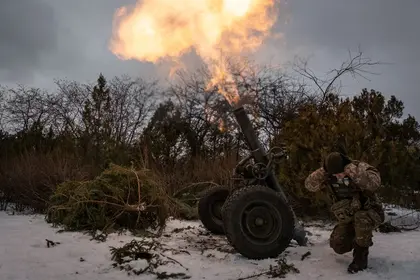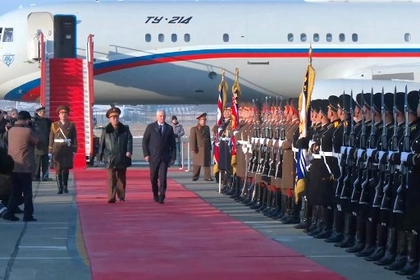Bakhmut, amidst heavy fighting that is increasingly becoming more street to street, is creating its own unique place in Ukraine’s history. It is literally, as we wrote on March 2 in the Washington Examiner, rapidly transcending into a town that is too tough to die.
Ukraine’s heroes are not all known yet, and no doubt there will be more, however, they will, in the passage of time, be as storied and remembered as those of American folklore who once walked another town that was too tough to die – Tombstone, Arizona.
- Obtain the most recent updates on the Ukraine situation today.
- Read the newest Ukraine news stories published today.
JOIN US ON TELEGRAM
Follow our coverage of the war on the @Kyivpost_official.
Tombstone, like Bakhmut, is located in a mining region of the southwestern U.S. In the early 1880s, the small town soon found its existence jeopardized by outsiders. A feud between two groups came to a head on Oct. 26, 1881, when, Wyatt Earp, and Doc Holliday – all names still well-known in the U.S. 142 years later – faced off against the Clanton Gang in what became known in legend as the “Shootout at the O.K. Corral.”
That epic American gunfight lasted only 30 seconds. Bakhmut, against all odds, has been holding out since August 2022 against the invading forces of Russian President Vladmir Putin’s so-called “special military operation.”
While Tombstone held out against the lawlessness of a handful of ranchers, Bakhmut has valiantly held out for seven months against all that Putin’s would-be Russian empire has been able to throw at the town comprising 16 square miles.

‘We Need to End that Horrible, Horrible War’ – Ukraine at War Update for Dec. 23
We may soon be nearing a tactical culmination in Bakhmut. But what the town means and what it has meant in the defense of Ukraine will not die. Chuck Pfarrer, a former U.S. Navy SEAL Team Six Squadron Leader, utilizing his Indications & Warnings Twitter feed, has provided a detailed day-to-day – often hour-to hour – synopsis of the battle for Bakhmut.
Using tactical maps and call-out text boxes, he has documented Russia’s concerted efforts to envelop Bakhmut. According to Yevgeny Prigozhin, founder of the Russian state-backed mercenary Wagner Group, the city is now nearly surrounded.
Overcoming the odds
Part of Bakhmut’s role in the defense of Ukraine is the significant strategic military drain on Russian munitions, equipment, and troops. The Russian “burn rate” in all three categories in exchange for marginal gains in geography is mind-boggling.
In the ongoing onslaught of Bakhmut, Russia reportedly has a 10 to 1 artillery advantage. Overall, throughout Ukraine and the Donbas, as Moscow presses its advantage in artillery, its forces are expending between 20,000 and 60,000 shells each day compared to an estimated 5,000 to 6,000 artillery shells by the Ukrainian defenders.
In Tombstone, the odds were relatively even. Not so in Bakhmut and the rest of the front in the Donbas. Nonetheless, Ukraine is overcoming those odds. In Vuhledar, for example, in a supporting effort, Russia reportedly lost 130 tanks and armored personnel carriers in a series of failed assaults that annihilated the 155th Naval Infantry Brigade.
Putin’s losses in manpower are even greater. Ukraine is imposing a 7 to 1 casualty rate exchange in Bakhmut alone and Russia is alleged to have lost more troops in Ukraine than in all of its military actions since World War II – upwards of 151,000 soldiers.
For now, Ukraine appears to be reinforcing Bakhmut, however, it is not clear to what extent, nor with what types of forces. The town itself is, as the New York Times reported, “a city in name only.”
Military analysts have said that Bakhmut has little strategic value, but its value to Ukraine transcends brick and mortar. It is where President Volodymyr Zelensky has chosen to make his stand – in effect his version of Tombstone’s O.K. Corral – and reminiscent of his legendary response to U.S. President Joe Biden’s administration when offered a chance to leave the country.
Zelensky’s legendary answer? “The fight is here – I need ammunition, not a ride.”
Bakhmut is also symbolically Tombstone, Bastogne, The Alamo, and Carthage all rolled up into one. Each of these storied cities has in their own way led to the downfall of a foe or an empire. In that same fighting spirit, Ukraine need not despair if Bakhmut falls in the days ahead due to a Ukrainian tactical retreat. Live to fight another day – and continue exacting a toll on the Russian army.
A Russian tactical victory would come at great strategic cost
If Bakhmut is overrun, while it would be a Russian tactical victory, it would be at a Pyrrhic cost. Essentially, Putin is swapping his delusional dream of a modern Kievan Rus’ empire in exchange for holding a single town – and perhaps only temporarily at that.
Tellingly, it is not military strategy compelling him to try and take Bakhmut. But, as Daily Beast reporter and Russian media expert Julia Davis frequently documents on her Russian Media Monitor channels on Twitter and YouTube, because Russian nationalists, propagandists, and milbloggers are telling him he must have it. That – and Putin’s own ego.
Russia taking Bakhmut therefore comes at great cost. Putin’s forces have expended an inordinate amount of equipment, munitions, and troops trying to conquer the city over the past seven months. They have crept forward, meter-by-meter, house-by-house, and have been bloodied and significantly weakened in the process. Furthermore, these battered Russian forces are vulnerable to a Ukrainian counter offensive, once U.S.-led war games conclude in Germany, tank crews complete their training in Poland, and new equipment and ammunition arrives in Ukraine.
Ukraine, when it comes to Bakhmut, can win either way. If the town holds, Putin and his generals will have wasted a considerable amount of Russia’s military capacity trying to capture it. If Kyiv withdraws from the city, Moscow’s cost of victory will have come at the expense of being better prepared to defend against the forthcoming Ukrainian Spring counter offensives in the Donbas or the assault to reclaim the Crimean Peninsula.
The more compelling question for Kyiv and NATO is whether or not Washington and Brussels will exploit lessons being learned on the battlefields in and around Bakhmut. Ukraine cannot continue to remain decisively engaged in the Russian way of war – mass infantry and artillery against a static target. Russia has clearly been reduced to World War I tactics, reminiscent of the Netflix revival of the classic movie All Quiet on the Western Front, which depicts an accurate portrayal of the defensive battles currently being waged in Bakhmut and the surrounding towns in the Donetsk Oblast.
Trench warfare
While Bakhmut has been the exception for Ukraine for reasons stated above, Kyiv cannot continue to fight in this type of attrition warfare environment. Trench warfare, no-man’s land, and bodies in various states of decomposition is not a winning formula for Zelensky.
As we have written in the past, let Moscow refight WWI. Ukraine, instead, must be freed up to fully fight this war in the same manner as NATO would if the alliance’s troops were fighting against the Russians – maneuver and combined arms warfare; the Maginot Line mentality must remain in the past.
The weapon systems and ammunition provided to date by the U.S. and NATO are primarily defensive in nature. Some, like the High Mobility Artillery Rocket System (HIMARS) have been altered to prevent firing munitions that can exceed 70 kilometers. But Ukraine needs extended-range munitions such as the Army Tactical Missile System (ATACMS) and F-16 fighter-bombers to put Russian formations “at risk” and to deny them sanctuary.
Using these would also provide counterfire capability against Russian ballistic missile and drone launch sites. Equally of importance, Ukraine’s troops would finally be able to fully maneuver as a combined arms team once German Leopard 2 Main Battle Tanks and U.S. Bradley Infantry Fighting Vehicles arrive in larger numbers.
The strategic opportunities stemming from Bakhmut staring Ukraine and NATO in the face cannot be understated. Russia is trapped fighting using WWI tactics and yet, for now, those tactics are allowing Putin to trade mass for single digit kilometers.
Unless China significantly ups its military aid to Moscow to include lethal weaponry, Ukraine has a window to fight Russia using modern NATO combined arms warfare tactics, while Putin would be largely limited to using outdated and costly WWI and WWII strategies in response.
Biden must seize this moment to affect an end-state that results in Ukrainian victory and total expulsion of Russian forces from all of Ukraine’s territory, including Crimea. Retired U.S. Army General Ben Hodges, the former Commander of U.S. Army Europe, has long articulated the plan that can do it. Now Washington must give Zelensky the means of pulling it off.
Bakhmut, one way or the other, will live on. Whether the city is rebuilt, turned into a Ukrainian national monument, or transcends into a ghost town, Ukraine’s Tombstone will forever haunt and remind Putin of his failures, war crimes, and crimes against humanity in the fields, forests, and cities of Ukraine.
Putin, justly, is finding out that Bakhmut, gloriously, is a town too tough to die and that Ukraine, likewise, is a country that simply refuses to die.
Copyright 2023. Jonathan E. Sweet and Mark C. Toth. All rights reserved.
Jonathan Sweet, a retired Army colonel, served 30 years as a military intelligence officer. His background includes tours of duty with the 101st Airborne Division and the Intelligence and Security Command. He led the U.S. European Command Intelligence Engagement Division from 2012-14, working with NATO partners in the Black Sea and Baltics. Follow him on Twitter @JESweet2022.
Mark Toth is a retired economist and entrepreneur who has worked in banking, insurance, publishing, and global commerce. He is a former board member of the World Trade Center, St. Louis, and has lived in U.S. diplomatic and military communities around the world, including London, Tel Aviv, Augsburg, and Nagoya. Follow him on Twitter @MCTothSTL.
The views expressed are the author’s and not necessarily of Kyiv Post.
You can also highlight the text and press Ctrl + Enter






